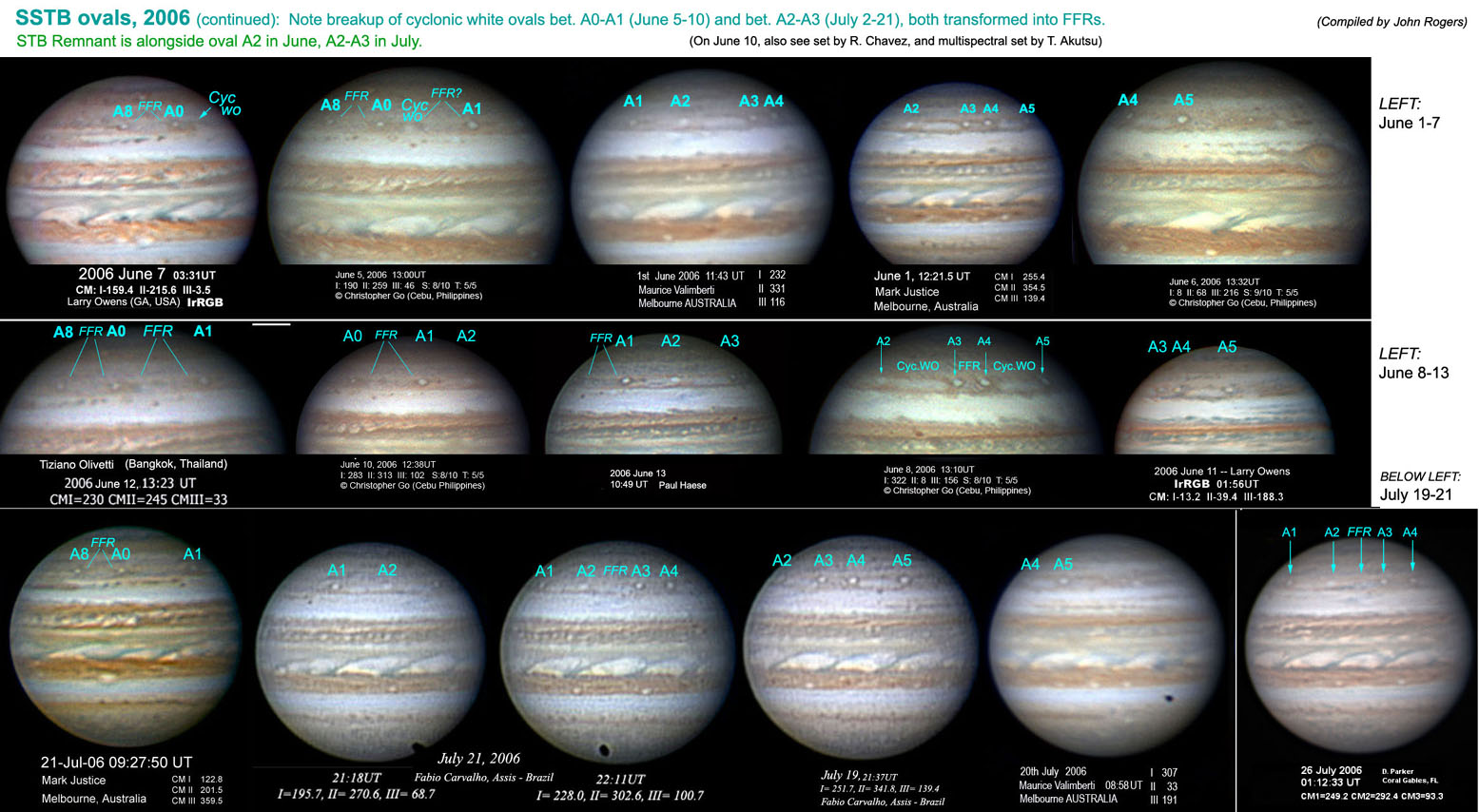
[11] NEBn: Interim reports on the SSTB (cyclonic white ovals break up) and STB (A remnant or a forerunner?) (Reports, 2006 July 30)

SSTB:
AWOs persist, cyclonic white ovals break up.
The
set of S.S. Temperate anticyclonic white ovals (AWOs) continues to be an
eye-catching feature of hi-res images: in order, A8-A0-A1-A2-A3-A4-A5.
The attached image set shows this array in 2006 June and July.
Most
or all of them are separated by cyclonic circulations, which are more variable
in appearance. In these image there are two main types: white ovals (which tend
to expand in length forming white lozenges, as has occurred between A2-A3 and
between A4-A5), and folded filamentary regions (FFRs, which are like miniature
versions of the rifted regions in SEB and NEB, and are hard to detect in
ground-based images). The best images can now distinguish these cyclonic
features and document their transformations.
In
this series, a small white oval between A0-A1 disappears suddenly between June 5
and 10, becoming a FFR; actually it probably merges into a pre-existing FFR f.
it. Then note the long, long-lived
white lozenge between A2-A3, which seems to have lower contrast from June 8
onwards but is still present on July 2; but in the next images, July 21 and 26,
it too has broken up to form a FFR. It
may be significant that this happened as it was passing the STB Remnant (see
below), which could destabilise the adjacent SSTB; perhaps the cyclonic white
lozenge between A4-A5 will do likewise in a few months' time.
These white lozenges tend to expand (like their equivalents in the STB:
see my book pp.54 & 231), perhaps pushing the adjacent AWOs apart, and as
the white lozenge broke up, oval A3 immediately rebounded from oval A4, to which
it had been uncomfortably close.
STB:
A remnant or a forerunner?
The
STB Remnant (seen in the same images) is an obscure faint bluish streak in
otherwise whitened STB latitudes, but I think it is important.
From its latitude and appearance, it is probably a cyclonic disturbance,
perhaps like a FFR. It thus constitutes an active complex in the STB,
approximately half way round the planet from the other such complex; but it has
no large AWO.
This
second complex is essentially an 'orphan' cyclonic circulation such as those
observed by the Pioneer and Voyager spacecraft (see book p.228).
In those days, in addition to the 3 widely spaced AWOs, the orphan
cyclonic region divided the STB into four.
At other times the STB was just divided into three by the three great
AWOs. In the late 1980s, the STB
became divided into two, with one complex containing AWOs BC + DE, and the other
containing oval FA. When they all
combined into one complex, new spots arose to create a second complex which
existed from 1998 to 2003. (This is the situation shown in the Cassini movie.)
When it too merged with the first complex (now characterised by the single AWO
BA),
new spots again appeared on the other side of the planet, and these have
persisted as the present STB Remnant.
In
summary, there must always be 2-4 active complexes spaced around the S.
Temperate domain. If there is a large gap, a new feature arises to maintain the
spacing, often an orphan cyclonic circulation.
But
we are also waiting for another phenomenon to occur. As there is only one great oval left, will the S. Temperate
domain again become subdivided into several large anticyclonic cells which
contract to form a new generation of great AWOs, as happened from 1940 onwards
(see book pp.223-228)? The first
sign of that happening was the appearance of three short dark features (dusky
STZ or STB(S)), subdividing the STZ. This could describe the appearance of the
two active complexes in the present STB! They
do not have the circulation patterns expected for the origin of great
anticyclonic circulations (see the Cassini movie): but could they be the
fore-runners of the same process? Time
will tell.
John
Rogers, 2006 July 30